Alfred Russel Wallace
Biography
EUGENE M. MCCARTHY, PHD GENETICS
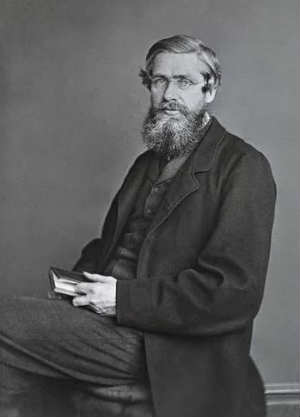
(1823–1913)
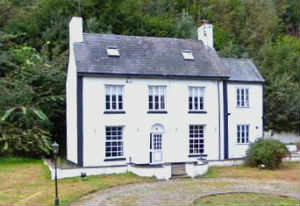 Wallace's birthplace (Kensington Cottage)
Wallace's birthplace (Kensington Cottage)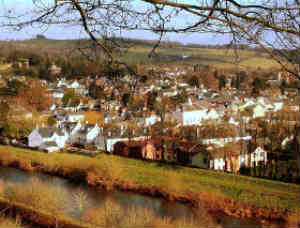 The town of Usk today, taken from Wallace's side of the river, which is visible in the foreground. Usk is in the southeastern part of Wales.
The town of Usk today, taken from Wallace's side of the river, which is visible in the foreground. Usk is in the southeastern part of Wales.(1825–1892)
The British naturalist, biogeographer, author, humanitarian, Alfred Russel Wallace (Jan. 8, 1823–Nov. 7, 1913) is best known for developing a theory of evolution through natural selection independently of Charles Darwin.
Alfred Russel Wallace was born on January 8th, 1823, the eighth child of Thomas Vere Wallace and Mary Anne Wallace. His oddly spelled middle name was the result of a mistake at the time of registering his birth, which was never corrected.
His place of birth was Kensington Cottage, which stands just across the Usk River from the town of Usk in southeastern Wales. The Wallaces, who were not Welsh, had been forced to move to Kensington as a measure of economy after Alfred's father squandered most of his inheritance on a series of poor business decisions. They had up to that time lived as an upper middle class family in Hertford just north of London.
Supposedly, the Wallaces were descendants of the Scottish warrior chieftain William Wallace, of Braveheart fame. But, in fact, Alfred left home at such an early age that as an old man he said he knew few specifics about even his more recent ancestors. One of his typically speculative comments on this topic (My Life, 1905, vol. 1, p. 5) was that on his mother's side "the family were not improbably French refugees after the massacre of St. Bartholomew in 1572."
In 1835 his father, who seems always to have been improvident in his investments, was swindled out of most of his remaining property, and the Wallaces then fell on real hard times. Alfred had to stop attending school at the early age of 13, and yet, he educated himself and was eventually the author of many books on evolution and natural history.
While teaching school in Leicester in 1844, aged 21, he met Henry Walter Bates (1825–1892). Like Wallace, Bates had left school at an early age and lacked any formal education in natural science. But both were fanatical beetle collectors, and together they scoured Leicestershire for specimens. In 1848, after reading about the adventures of famous naturalist travelers such as Alexander von Humboldt and Charles Darwin, they embarked for Brazil in hopes of a collection bonanza.
Lingering near the coast after their arrival, they spent a year collecting in the vicinity of Belem, at the mouth of the Amazon. Eventually, however, they had a falling out, and Wallace ended up going off on his own. He traveled far inland to explore the Rio Negro, a major river deep in the western Amazon Basin. There, he collected specimens of the flora and fauna, gathered information about the indigenous peoples, and made notes on the geography.
In the summer of 1852, he tried to return to England with everything he had collected on his inland expedition, but three weeks out at sea his ship, the brig Helen, caught fire and sank. He escaped with the crew, spending ten days at sea in a lifeboat, but thousands of carefully prepared specimens and all of his field notes went down with the ship. Fortunately, he had insurance and was at least compensated financially for his loss. He also had many specimens that he had shipped home separately before he left Belem for the Rio Negro. He later wrote (My Life 1905, p. 306),
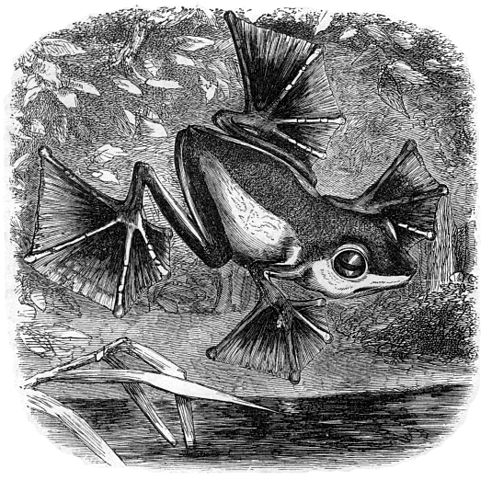
Wallace's Flying Frog
(from The Malay Archipelago) |
Back in London, living on the insurance payment and the proceeds of specimen sales, he spent the next two years publishing several formal papers about his experiences, as well as two books (A Narrative of Travels On the Amazon and Rio Negro and Palm Trees of the Amazon). He then set out again, this time for the Malay Archipelego (now Indonesia and Malaysia). There he spent the next eight years, collecting more than 125,000 specimens — birds, snakes, amphibians, butterflies and, of course, beetles — of which a thousand would be forms new to science — including the then unheard of Flying Frog (above right).
Theory of Evolution through Natural Selection. In 1858, Wallace sent Darwin an essay from Borneo, entitled On the Tendency of Varieties to Depart Indefinitely from the Original Type, that precipitated Darwin into panic. It gave a full account of the theory of natural selection. At the time, Darwin had been working on his version of the theory for some twenty years, but published nothing.
Darwin told his friends Charles Lyell and Joseph Hooker, two prominent British scientists (the latter was one of Darwin's proteges), about Wallace's paper. Indeed, Lyell had known Wallace was working on an evolutionary theory and had been warning Darwin to publish.
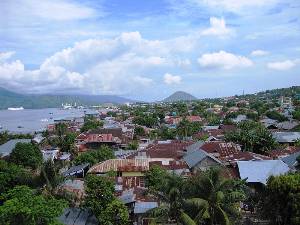
Ternate today. Here, Alfred Russel Wallace, while lying ill with malaria, conceived the theory of natural selection independently of Charles Darwin
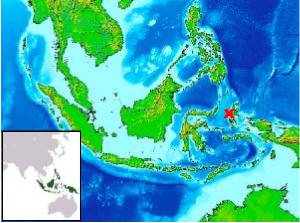
Location of Ternate
|
Wallace had been away since 1854, on his expedition to the Malay Archipelago. Years later, in his autobiography, he wrote how the theory came to him, in February 1858, in his bungalow on the remote island of Ternate (/"turn-NAW-tay"/). "At the time in question I was suffering from a sharp attack of intermittent [malarial] fever, and every day during the cold and succeeding hot fits had to lie down for several hours, during which time I had nothing to do but to think over any subjects then particularly interesting me. One day,
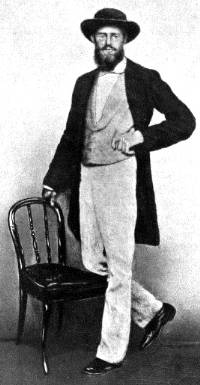
Alfred Russel Wallace
Singapore, 1862 |
When Darwin received Wallace's manuscript, he sent it on to Lyell. In the covering letter, he rued his procrastination:
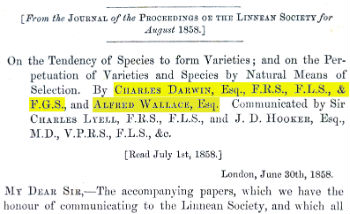
|
| Screenshot of the title page of "On The Tendency of Varieties to Depart Indefinitely from the Original Type." Note that Darwin appears as first author, though Wallace wrote the paper. |
Hooker and Lyell came to the rescue, arranging for Darwin to publish, alongside Wallace's formal paper, a hurried extract from a manuscript and a personal letter to his friend Asa Gray in which he had sketched his own ideas on natural selection. Darwin's name stood in the position of first author of, the article (see image right), entitled On the tendency of varieties to depart indefinitely from the original type, even though it was entirely written by Wallace. Darwin's letters and Wallace's paper were read out together at the July 1 meeting of the Linnean Society. Darwin then rushed the Origin of Species through to publication the following year.
Many have questioned this course of action (the now famous "Delicate Arrangement"), since it was done without Wallace's knowledge or consent. Even Darwin expressed trepidation at the proceedings. As he later wrote in his autobiography:
Questions of priority could certainly have been raised. But Alfred Russel Wallace was a modest man, and a considerably younger one than Darwin. He later wrote Darwin and eschewed all credit for the theory. As he put it in his letter, "I shall always maintain it to be actually yours and yours only." And, in fact, in correspondence Darwin regularly did refer to it as "my theory."
In particular, historians have questions about the concept of divergent evolution, which does not appear in any of Darwin's writings prior to his reading Wallace's manuscript, which did explicitly describe it. As Richard Milner (1993, p. 140) writes,
There has been much recent dispute among scholars about why Darwin came to understand divergence so late in the day, or even whether he might have lifted the idea from Wallace. Despite the extraordinary documentation of the Darwin correspondence (some 14,000 letters), it is disturbing that certain crucial documents are missing, such as Wallace's very first letter to Darwin, written in October 1856 from Malaysia, and the "lost letters of 1858" which immediately preceded the composition of the Origin of Species.
Wallace's letter reached Darwin in April, 1857, five months before Darwin sent Asa Gray, the American botanist, an updated summary of his evolution theory, the product of 20 year's thought and work. He had written out sketches of this ideas before (1842, 1844), but the latest version contained something significantly new — the "principle of divergence."
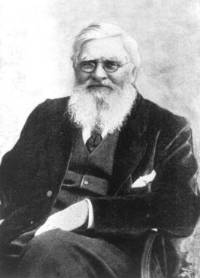
Alfred Russel Wallace in old age
|
No doubt, Darwin's wealth was one reason that he ended up with most of the credit for the theory. Darwin was a member of one of the richest families in England. Moreover, Darwin's writings about the voyage of the Beagle had made him famous. His riches, social prominence, and fame as an author put the younger, less well-known, and relatively impecunious, Wallace in the shade.
Darwin had, of course, been working on an evolutionary theory longer than Wallace had. Still, the question remains whether he would ever have published if Wallace's manuscript had never arrived in the mail.
Darwin's comments about Alfred Russel Wallace (in the Autobiography) >>
The effect of Darwin's wealth on his ideas >>
Alfred Russel Wallace - © Macroevolution.net
- Selected Works of Alfred Russel Wallace: Travels on the Amazon and Rio Negro (1853); On the Tendency of Varieties to Depart Indefinitely from the Original Type (1858); The Malay Archipelago (1869); Contributions to the Theory of Natural Selection (1870); The Geographical Distribution of Animals (1876); Tropical Nature, and Other Essays (1878); Island Life (1881); Darwinism: An Exposition of the Theory of Natural Selection, with Some of Its Applications (1889); My Life (1905).
-
Alfred Russel Wallace's exact dates of birth and death: 8 January 1823 (in Usk, Wales) — 7 November 1913 (at Broadstone, near Wimborne, in Dorset, UK, and was buried there).
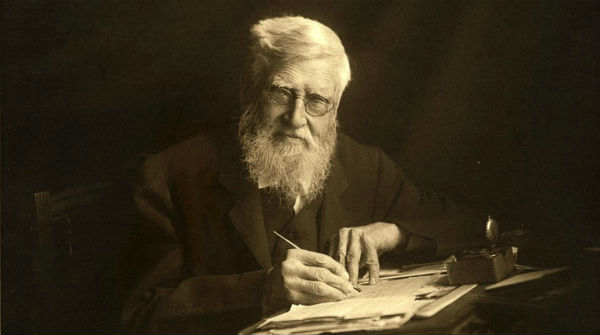
Alfred Russel Wallace